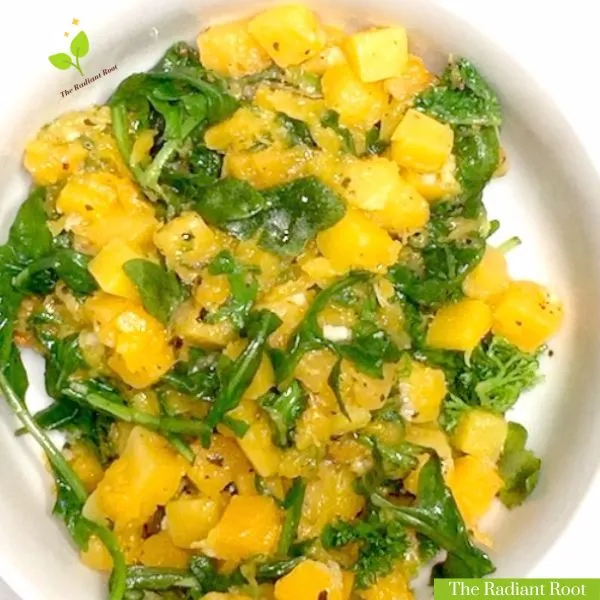
Servings: 4 1/2 cup serving
Calories: 101kcal
Equipment
Ingredients
- 2 cups thawed frozen butternut squash
- 2 cups arugula
- 3 cloves garlic peeled and pressed
- 1 tsp fresh parsley
- 1 tsp dried basil
- 2 tbsp extra virgin olive oil
Instructions
- Place the frozen butternut squash in a bowl and thaw to room temperature (about 30 minutes).
- Rinse the arugula under cool water and pat dry. Trim off any tough stems to ensure a tender texture and set aside.
- Peel the skin off the garlic cloves using a garlic peeler. Then crush them with a garlic press.
- Rinse and pat dry the fresh parsley. Finely chop fresh parsley leaves, then measure 1 tsp for your recipe.
- Measure out 1 tsp of dried basil and 2 tbsp extra virgin olive oil, then set them aside.
- Place a large skillet over medium heat. Add butternut squash, olive oil, and garlic.
- Continue to cook the butternut squash mixture until soft stirring occasionally (about 15 minutes).
- Add the parsley and basil then cook for another 5 minutes, stirring often.
- Gently fold in the fresh arugula. Toss it lightly with the other ingredients until it wilts and turns a deep, vibrant green (about 2 minutes).
- Let it cool for 1 to 2 minutes and enjoy.
Video
Notes
This section has recipe tips and tricks, additions/substitutions, and variations along with how to store and reheat leftovers.
Recipe tips and tricks
Tips for great recipe results: Prevent overcrowding: Use a large pan to avoid overcrowding, ensuring even cooking and enhanced flavor. Increase prep efficiency: Opt for frozen or pre-cut butternut squash for a quicker preparation process. Cut with care: If using fresh butternut squash, cut with a controlled, steady motion. Microwave briefly if too dense. Enhance garlic flavor: After crushing garlic, let it sit for a few minutes before adding it to the skillet for intensified flavor. Avoid overcooking arugula: Gently toss in arugula, cooking for only about two minutes until it turns bright green. Avoid overcooking to prevent wilting. Add herbs at the end: Introduce herbs like parsley in the last 7 minutes of cooking to preserve color and taste.Additions/substitutions/variations
Get recipe additions, substitutions, and variations in this section.Additions
Here are some recipe addition ideas. Please remember these or any other additions will alter the flavor, texture, and nutritional content of the recipe. Nutty crunch: Sprinkle toasted pecans, walnuts, or pine nuts for a nutty flavor and satisfying crunch. Savory and creamy: Top with vegan Parmesan, feta, or goat cheese Increased sweetness: Diced apples, pears, pomegranate seeds, craisins, or raisins Brighten with citrus: Add a teaspoon of fresh lemon or orange zest for a bright taste. Spicy kick: Add heat with red pepper flakes*, cayenne*, or chili pepper*; adjust to taste preferences. Tangy taste: Drizzle with balsamic glaze, apple cider vinegar, or lemon/lime juice for a tangy flavor. Caramelization boost: Increase caramelization with browned sweet onions, shallots, or carrots. Herb infusion: Infuse with thyme, sage, or rosemary for an earthy, floral, savory, or peppery flavor. Additional greens: Add a cup of spinach or kale for a boost of nutrients, texture, and mild or slightly earthy tastes. Stir in during the last few minutes of cooking. Enhance with salt: Add a pinch of salt for a balanced flavor. Feel free to customize the recipe with these additions, keeping in mind that each will alter the taste, texture, and nutritional content.Substitutions
Here are recipe ingredient substitutions: Butternut squash: Opt for fresh or raw pre-cut peeled squash*. If unavailable, try frozen sweet potatoes* or fresh sweet potatoes*, carrots*, acorn squash*, pumpkin, or delicata squash* peel and cut chunks. Adjust cooking time accordingly about 15 to 20 minutes. Arugula: Substitute with 2 cups of spinach, kale, or other leafy greens. Garlic: Use the following:- 3/4 to 1 teaspoon for garlic powder
- 3/4 teaspoon for granulated garlic
- 1 1/2 to 2 teaspoons for garlic paste
- 1 to 1 1/2 teaspoons for jarred minced garlic
Variations
Seeking diverse sautéed squash recipes? Consider these options: For time efficiency, swiftly thaw frozen butternut squash in the microwave for 1-2 minutes. If frozen squash is unavailable, opt for a speedy preparation using pre-peeled and diced raw squash*. Enhance convenience by prepping parsley and pressing garlic in advance, storing them in an airtight container for up to 3-4 days.Sauteed butternut squash storage options
Here is information on how to store recipe leftovers: Allow sauteed butternut squash to cool to room temperature. Transfer leftovers to an airtight container. Refrigerate for 3-4 days. For longer storage, freeze in a freezer-safe container for 3-4 months. Thaw in the fridge overnight before consuming, considering potential texture and flavor changes.How to reheat leftovers
Reheat sauteed butternut squash and arugula leftovers by letting them thaw or reach room temperature. Reheat it on the stovetop or in the microwave. On the stovetop, cook in a large skillet with a splash of water or oil for about 5-10 minutes, until thoroughly heated. In the microwave, heat in 30-second intervals (1-3 minutes), stirring between, until thoroughly heated. Adjust timing as needed.Nutritional information
*Nutritional information is estimated using Nutrifox nutrition label maker*Nutrition
Serving: 0.5cup | Calories: 101kcal
Tried this recipe?Let us know how it was!